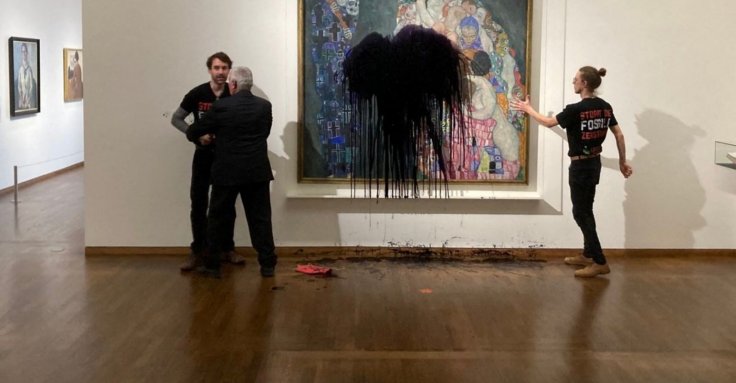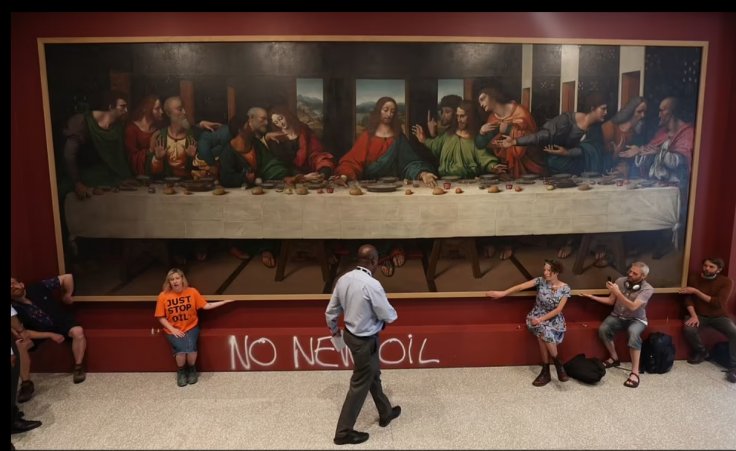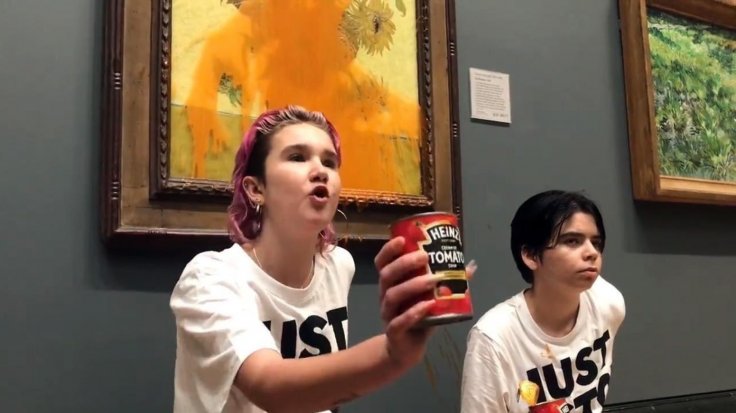Climate activists in Austria attacked Austrian painter Gustav Klimt's 1915 masterpiece 'Death and Life' at Vienna's Leopold Museum on Tuesday by pouring a black oily fluid over it. Two members of the group 'Last Generation' spilled dye over Klimt's masterpiece before one of the members glued himself to the glass enclosing the priceless work of art.
One of the security guards at the museum was able to restrain one of the activists before the police arrived. The museum authorities haven't yet confirmed if the painting has been damaged but sources claim that it may have been luckily saved because it was behind a glass cover.
Damaging Piece of History
NOW - Attack on Gustav Klimt's "Death and Life" painting with black liquid at the Leopold Museum in Vienna. pic.twitter.com/oi42lHlTnD
— Mark (@markmaycot) November 15, 2022
In an act of protest against their government's use of fossil fuels, members of the group Last Generation in Austria damaged the 1915 painting 'Death And Life' at the Leopold Museum in Vienna. The museum officials are now worried that the protesters might have damaged Klimt's painting.
"Restorers are working to determine whether the painting protected by glass has been damaged," the museum's spokesman Klaus Pokorny said.

After throwing the liquid on the painting, one activist was pushed away by a museum guard while another protester glued his hand to the painting's frame. The group defended their actions on Twitter by claiming that they were in opposition to "oil and gas drilling," which they described as "a death sentence to society."
In a video of the incident that the group shared online, one of the activists can be heard saying, "we have known about the problem for 50 years - we must finally act, otherwise the planet will be broken".

"Stop the fossil fuel destruction. We are racing into a climate hell."
When police arrived at the museum following the assault, the black liquid was immediately washed off the glass enclosing the picture, according to Austria Press Agency. The activists were able to smuggle the liquid inside the museum despite strict security measures at the entrance by concealing it in a hot water bottle under their clothing, according to the news agency.
Not The Correct Way
In recent weeks, protests against the lack of action against climate change have resulted in attacks on numerous masterpieces throughout Europe. The Leopold Museum's director, Hans-Peter Wipplinger, told APA that while the climate activists' worries were legitimate, "attacking works of art is definitely the wrong way to implement the targeted goal of preventing the predicted climate collapse."

He urged the group to come up with alternate means to voice their objections. The culture minister of Austria acknowledged the campaigners' "concerns and also the desperation," but also criticized their method of protest.
"I do not believe that actions like these are purposeful, because the question arises whether they do not rather lead to more lack of understanding than to more awareness of the climate catastrophe," Andrea Mayer said.
🟢NOW - Attack on Gustav Klimt's "Death and Life" painting with black liquid at the Leopold Museum in Vienna.
— Randy N ðŸ¸ðŸ‡ºðŸ‡¸ðŸ³ï¸â€ðŸŒˆ (@RandyN79) November 15, 2022
💬staged.. security guard had to make sure he dragged him back into the video and lightly struggle with the guy. 🤦ðŸ»â€â™‚ï¸ pic.twitter.com/6xEYWPygvH
As part of a day sponsored by the Austrian oil and gas company OMV, the Leopold Museum offered free admission on Tuesday.
The Klimt piece is an oil on canvas painting in the Art Nouveau style that features a group of hugging, partially naked people on the right side and death on the left. It's one of the most recent works of art that climate activists have targeted to raise awareness of global warming.

In recent months, a variety of activist groups have held many protests, blocking roadways and even hurling mashed potatoes at a Claude Monet painting in Germany.
Last month, the British group Just Stop Oil splashed tomato soup upon Vincent van Gogh's "Sunflowers" at the National Gallery in London.

The frames of an early replica of Leonardo da Vinci's "The Last Supper" at the Royal Academy of Arts in London and John Constable's "The Hay Wain" at the National Gallery were also covered in adhesive by Just Stop Oil protesters.
As part of a protest against climate change, a group of activists also dumped pea soup onto a Vincent van Gogh painting in Rome. They warned that this action would not end until more was done to address the issue.
The Dutch painter's 1888 work, "The Sower," which shows a farmer planting his crop in front of a stifling sun, was on display behind glass and unharmed.









